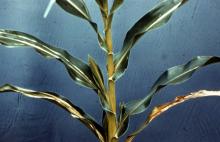Cause This disease is observed only rarely and is not considered a significant problem for Pacific Northwest corn plantings. It is caused by Pantoea stewartii subsp. stewartii (syns. = Erwinia stewartii, Xanthomonas stewartii), a bacterium vectored by several insects including the 12-spotted cucumber beetle and seed corn maggots. However, the corn flea beetle is the most important insect for overwintering and spreading the bacterium. Warm winters favor survival of the beetle vectors and increase the risk of Stewart's disease. Nutrition influences disease severity: high ammonium, nitrogen, and phosphorus levels tend to increase susceptibility; high calcium and potassium levels tend to decrease susceptibility. High temperatures also enhance disease development.
Symptoms Initially, leaf lesions originate from flea beetles' feeding scars. Leaves show linear, pale green to yellow streaks with irregular or wavy margins parallel to the veins. Entire leaves may be blighted as lesions coalesce. Infected plants wilt rapidly and may die.
Cultural control
- Use resistant hybrids.
- Control insect vectors. See the PNW Insect Management Handbook for details.


